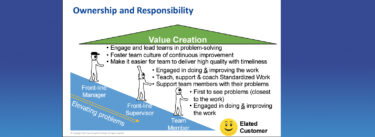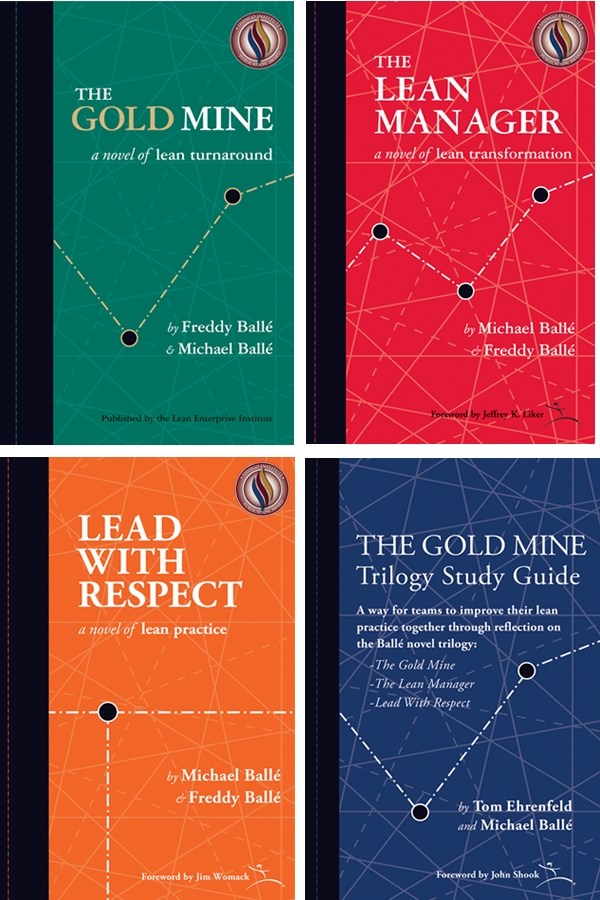(During The Way to Lean, a free webinar on the “lean trilogy” approach to deeply understanding and applying kaizen daily, we received more questions than presenter Michael Ballé could answer during the Q&A session. Michael is answering them, including the question below, in his Gemba Coach column -Ed.)
Dear Gemba Coach,
What is your opinion about transformation process steps? First we choose a problem and start problem-solving processes (A3 or 8-step methods) and after the steps create our first standards; OR first write down the processes as they are now and choose problems to solve by measuring the gaps between first standards and our goals?
Well, it all depends what you want to transform.
Personally, I try to transform the story business leaders tell themselves about their company, to find a new story that better fits the facts and leads to more effective action.
For instance, I was just recently on a gemba with a CEO I’ve known for eight years. The story he told himself about his company at the time was that they were an aging startup founded on an innovative high-tech process (material injection molding) that would make bespoke parts for clients to prove that the technology could replace machining parts on a wide range of applications.
After clearing the window with the lean tools (i.e. looking for a better story) for a couple of years, I convinced myself that to stabilize the company (less mura, and the resulting muri and muda), we should show that the company was a world leader on a few products such as watch clasps and pen clips, and shift from selling the tech to selling products.
Now, was I right? At the time, of course, I wasn’t sure and my part of the work was questioning all the time this hypothesis. But it turns out that, yes, it’s a better story, it helped us survive the disappearance of the main client (luxury telephones – imagine what happened when the iPhone came out) and the post-Lehman Brothers debacle. The company is going strong now, and using a product development value stream from engineering into production, although nothing fits well (large ovens, injection presses, the works). It’s hard, but the new story is a better story for this company.
How to Find Your New Story
All this is to say, that the business story in the books is not background to write lean as a novel – it IS the story. Lean is applied to a business case, to change the story. In Lead With Respect Jane Delaney has to change the story from large, low income, low interest projects back to partnering with clients through smaller, more flexible more customer focused, more tech savvy work. She has to fight the sales guy for this change, recapture the interest of her tech guy, and plunge back into understanding code and coding. That’s the story. Lean is the way she (1) discovers the new story, and (2) makes it happen.
How do you find a new story? By applying the lean tools at four levels:
- Find out what customers prefer by visualizing complaints: what do customers look for in your products and services? What do they like, what don’t they like so much and what do they really mind? The first story is the customer story, customer by customer: is it what we think?
- Clear the window by setting up a pull system: a wall-to-wall pull system will not solve any of your problems but it will certainly reveal strengths and weaknesses of people and processes, and teach you a lot about how your organization really works (as opposed to the way you think it works)
- Get senior execs to work together: this is where I use A3s, mostly, by setting up a weekly presentation, turn by turn, by management committee members to each other in order to better understand the problems each faces, forgo turf wars and give a hand instead.
- Start on the gemba with zone control: a simple roll-out plan of one 5S training per week, so that the area has been covered wall to wall (including offices) and each team is taught 5S to organize themselves better to hold their own standard work and starts owning their area and feeling responsible for it.
I don’t roadmap this much, but try to get the CEO to start all four programs at once (they touch different people) as well as a beginning a disciplined gemba program for herself to check the progress of these various initiatives and learn straight from the gemba.
More Than Opex
With that set up, we ask ourselves continuously:
- What would be better quality for the customer: both in terms of better performance of our product and services and in terms of quality (failures and missed deliveries). This is a deep, on-going discussion without an ending because customer preference expressions vary, and you’ve got to make some gambles; then we ask ourselves how to build it into the product by building it into the process.
- What would better flow look like: focusing on radically improving flow leads to some surprising insights that completely change the way we look at the business as a whole. It doesn’t help you get it done right away, but certainly opens new perspectives.
- Who will lead these changes: as gemba conversations progress, A3s roll out and kaizen on the gemba starts happening systematically, some execs appear as leaders (not necessarily the most talkative or charismatic) and some others are revealed to be anchor draggers (sometimes those who talk a good game), so we start looking at who actually walks the talk in order to build the core leadership team that will take the transformation forward by shaping the future company according to their own learning and insights.
There is far more to lean than operational excellence. Lean is really about finding new, better ways to serve customers together, make money, and benefit society in the process. It’s both a tall order and an exciting challenge. And it requires insight as much as discipline. Rolling out tools and transformation processes or roadmaps are only the start : where do we find a better story from time spent on the gemba on better observation and better discussion.






